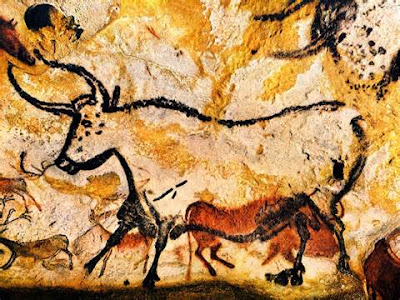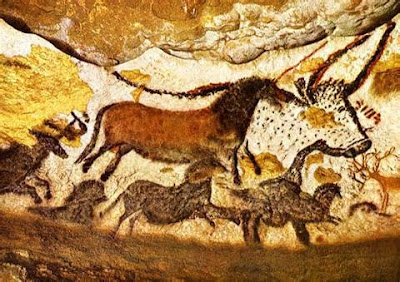Continuing the quest for shadows in rock art, specifically the majestic art of Europe’s painted caves.
Countershading on modern horses. Internet photograph, public domain.
The normal color pattern in many large herbivores such as portrayed in Europe’s painted caves is described as “countershading” wherein the fur tends to be darker on the top of the animal and lighter on the underside.
“Countershading, or Thayer’s Law, is a method of camouflage in which an animal’s coloration is darker on the upper side and lighter on the underside of the body. This pattern is found in many species of mammals, reptiles, birds, fish, and insects, both predators and prey, and has occurred since at least between 145.5 and 65.5 million years ago, or the Cretaceous period.” (Wikipedia)
There are other theories than camouflage for the evolution of countershading. “Many theories about countershading suggest that the dark color of the skin or fur on top, containing melanin, shields against ultraviolet radiation and helps animals get more heat from sunlight. But one of the oldest theories suggests that countershading enhances visual camouflage by counteracting the effects of light and thus making animals harder to see. In other words, if an animal is darker on top and lighter underneath, this can offset shading from light and make it harder for predators to detect it.” (Levine 2016)
The wild equines (Equus ferus ferus) found in Europe at that time are assumed to have appeared much like the last truly wild horse in the world today, Przewalski’s horse (Equus ferus przewalski). “Several genetic characteristics of Przewalski’s horse differ from what is seen in modern domestic horses, indicating neither is an ancestor of the other. For example, the Przewalski has 33 chromesome pairs, compared to 32 for the domestic horse. Their ancestral lineages split from a common ancestor between 38,000 and 160,000 years ago, long before the domestication of the horse.” (Wikipedia)
The phenotype of the Przewalski is a good match for many of the painted horses from the caves. “The Przewalski’s horse is stockily built, smaller, and shorter than its domesticated relatives. Typical height is about 12 – 14 hands (48 to 56 inches, 122 – 142 cm), and the average weight is around 300 kilograms (660 lbs.).” (Wikipedia) Many of the painted examples show this stocky build with relatively short legs.
The Przewalski’s horse’s coat pattern is based on a bay or dun coloring of medium brown with distinct countershading. This is exactly the pattern of many of the horses from wall paintings in the caves of Lascaux and Chauvette with hair colors ranging from red to black.
Most of the horses portrayed in European cave painting show this countershading. In other cases animals that should bear a countershaded patterning are found with darker underneath. I would suggest that this represents a variation of the cast shadow – dimensional shading. With a light source above a three dimensional object direct light hits the top of the object making it brighter, while the bulk of the object obscures the bottom of the object causing less light to reach it rendering it less brightly illuminated.
If this is correct, not only were the cave artists producing a marvelously realistic result in the presence of their animal subjects, they were also portraying the effects of light and shade on three-dimensional surfaces, a subject taught today in basic art classes – did the painters of Lascaux and Chauvette take a class? This focus on the effects of light and shade in art was seldom seen again until the studies of the great Leonardo da Vinci and later the French Impressionism of Monet, both of whom studied the effects of light falling on a surface. Were the cave painters indeed scientific artists like Leonardo, or Impressionists, or both?
NOTE: Some images in this posting were retrieved from the internet with a search for public domain photographs. If any of these images are not intended to be public domain, I apologize, and will happily provide the picture credits if the owner will contact me with them. For further information on these reports you should read the original reports at the sites listed below.
REFERENCES:
Levine, Jennifer, 2016, The science behind animal coloration, 27 January 2016, Cell Mentor, http://crosstalk.cell.com/blog/the-science-behind-animal-coloration.
Wikipedia, Countershading, https://en.wikipedia.org/wiki/Countershading, accessed on 17 January 2022
Wikipedia, Equine Coat Color, https://en.wikipedia.org/wiki/Equine_coat_color, accessed 19 January 2022
Wikipedia, Przewalski’s horse, https://en.wikipedia.org/wiki/Przewalski’s_horse,
accessed 21 January 2022


























